Introduction
Technology has been a critical component in Man Group's global response to the threat of Covid-19. At the time of writing, 99% of Man Group’s employees are working from home, with only a limited number of Infrastructure staff maintaining on site facilities and technology services.
In this article, we review the steps the technology teams took to prepare for lockdown, discuss some of the challenges of ensuring our staff can continue to work productively from home, and ask how the last few months might change the workplace of the future.
Background
Man Group has 13 offices across the globe and the vast majority of our staff have an assigned, dedicated desk with a desktop personal computer. Although many departments had been offering various forms of flexible working to their staff, most of us would still come into the office regularly and a lot of our internal meeting culture was built around whiteboards and video conferences in our meeting rooms.
Over the last two years, Man Group has been investing in our End User Technology platforms including PCs, mobile devices, video conferencing in meeting rooms and all of the infrastructure that sits behind it. This investment was targeted at improving our support for flexible working so as to be able to attract and retain a diverse workforce, introducing new collaboration tools so we can work efficiently as a global team and ensuring the highest level of support and reliability for our staff. At the end of the day, it doesn't matter how powerful our machine learning platform is, or how many sources of market data we have available, if our staff can't access these systems.
We have traditionally offered two remote access systems at Man Group:
- Citrix – a secure remote access solution where company data remains in our data centres and can be accessed from personal computers at home with minimal risk;
- Cisco VPN – a solution for people with Man Group-issue laptops with greater offline functionality than Citrix.
The remote access systems had been designed to support all our users working from home if an office had to be closed. Previously, events such as train strikes or inclement weather required Man Group to have a significant number of employees using the access systems simultaneously. However, we had never performed a live test where every global office and every function was simultaneously sent home. All staff were required to use our remote access systems regularly to prove they could connect, but not everyone had performed all aspects of their job remotely.
Preparation
Man Group has offices in Hong Kong and Shanghai and our colleagues there were sent home in late January. The experience of closing those offices, and the challenges our staff faced when working from home, provided useful lessons that would help prepare the wider group for lockdown.
Throughout February and early March, we worked alongside our colleagues in Business Operational Risk, HR, Corporate Real Estate and the rest of the Infrastructure teams to prepare for a possible lockdown across our other offices. While the focus of this article is on the steps taken by the technology team, we acknowledge the considerable amount of work performed by other parts of Man Group that helped us prepare for the months ahead.
Testing
In the weeks before our UK and US offices were closed, Man Group ran two global, multi-day tests where we made staff working in critical roles work from home. The test was mandatory in all but a few cases, and ensured that our staff were able to perform all aspects of their job from home. The tests were extremely beneficial, allowing the business to not only check employee home setups, but also allowing us to consider what the technology team needed to do from a support perspective. These tests also allowed us to gradually ramp up the transition, flattening the initial wave of support calls.
Hardware
At an early stage in our planning, we sought to ensure that our most critical staff with high technology dependencies (including some of our Central Trading and Portfolio Management teams) were issued with PCs and monitors to use at home. This made their hardware set up nearly identical to that of the office, materially reducing any disadvantages from working from home.
Immediately after the first wave of tests, and as it became clear that our offices would be closed for some time, we also purchased IT equipment such as monitors, keyboards and headsets for use at home. If we wanted people to be able to work productively at home they would need similar equipment to the systems they had in the office and working off a small laptop screen for weeks on end would prevent that. Making an early decision on this helped most of our staff order equipment before retailers began to run out of stock as everyone else was sent home.
New Tools
The technology team was already scheduled to rollout a number of new tools in 2020 to support flexible working and collaboration across our global offices. As part of our COVID-19 response plan we decided to fast-track the rollout of four main products:
- Slack – a group chat platform similar to iMessage or WhatsApp;
- Cisco WebEx – an online audio and video conferencing platform;
- Cisco Jabber – a tool that allows staff to make and receive phone calls from their work landline when working remotely;
- Adobe Sign – an e-signature tool for signing contracts
Slack had been used within Man Group’s technology teams since 2019, but the wider group was still using Microsoft's Lync instant messaging platform. WebEx and Jabber were at a stage where the technical and security design was largely finalised, but the initial scope for rollout was limited and not due until later in 2020. Adobe Sign was probably at the earliest stage of assessment but it quickly became clear from our tests that not being able to sign contracts from home would be a significant issue. Over a 2-week period, the team was able to complete final testing, produce user documentation and deploy all three services to more than 1,400 staff.
Training, Documentation & Adoption
Trying to educate users to use the new tools in order to reduce support calls, was an obvious way to help the team, and a lot of effort was put into creating a knowledge portal that helped users through the initial steps of using the products. Rather than organising this by system or product names, the portal was arranged according to use cases identifiable to our staff (Figure 1).
Figure 1: Use Cases Dashboard
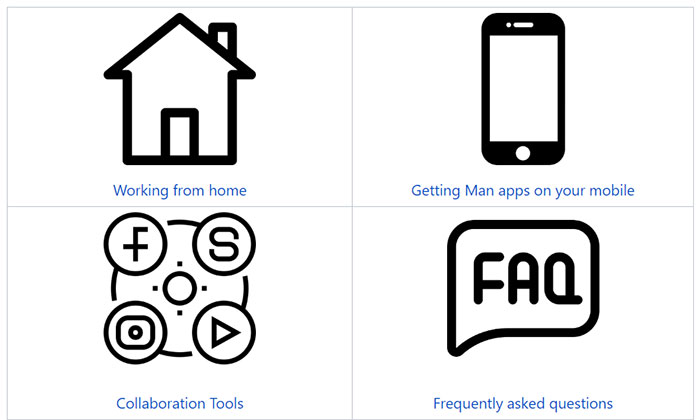
Source: Man Group. For illustrative purposes.
In addition to written articles, we also worked with our suppliers and project teams to run training sessions in the initial launch week of the new tools. These covered the basics of how to get up and running with the products, and were recorded and shared on our media streaming service, Microsoft Stream (another product released early as a result of the pandemic). Originally, the training envisaged staff still being in the office, but the team then had to quickly adapt to run it remotely over Webex. Eight training sessions were held over the first four days after the London office was closed and we had more than 200 people attend them from home.
Figure 2: Attendance at Collaboration Tools Training
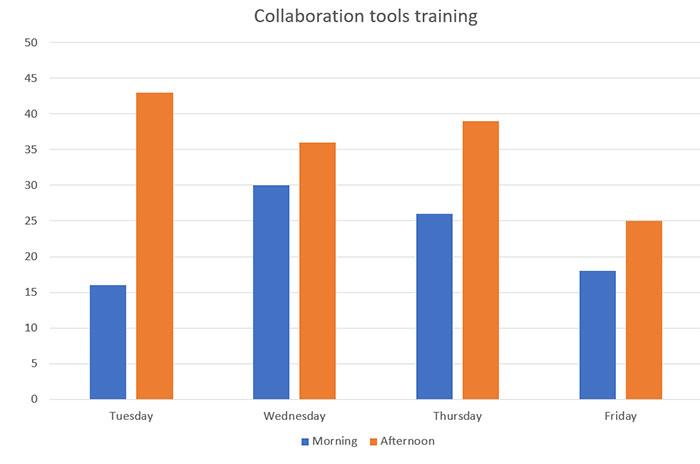
Source: Man Group. As of 31 March 2020.
Sometimes spreading the word across multiple departments can be challenging, as they all adopt different approaches to consuming information. So we leveraged our contacts across the business, our 'Adoption Champions', to help us. Our champions had existing relationships they could use to assist rollout and helped act as a buffer between the business and our support teams by providing a point person to answer the basic questions.
Support
Supporting people at home needed consideration, especially as we wouldn't be able to send people round to their desks to help them. To allow our teams to support devices off the network, whether that be Man Group laptops unable to connect, or personal devices, we moved quickly to purchase a product to enable this remote support: Teamviewer. This web based product could be used by our support teams to remotely connect to devices at home and for the support engineers to be able to see the issue and request control of the device to resolve it.
We also needed to make sure our support team were familiar with the new tools we'd launched. In most cases, we carefully manage the release of products, with gradual releases and intense training for support staff, but in this instance we didn't have that luxury. Slack and Jabber were relatively familiar to the team but for the other products we prioritised training for the teams and sharing information across our internal Slack channels.
Internet Bandwidth
As our business has evolved, more systems have moved or are moving into the cloud and our research staff are downloading larger alternative data sets. Those changes meant that we had already scheduled a number of upgrades to our internet capacity in 2020 and had already placed orders in December and January for increases in the UK and US. As part of our preparation, we were able to bring forward the commissioning of additional new circuits globally to ensure there was ample spare capacity for everyone to work from home. Our Networks team also worked to improve the spread incoming and outgoing internet loads across our circuits and sites to avoid any bottlenecks in our platform.
Monitoring
Significant time was devoted to improving our remote access monitoring and alerting platforms, ensuring we had data points to analyse our performance during both the initial working from home tests and when we moved the wider firm to a remote working model. Monitoring is often an area that gets overlooked in End User Technology platforms but is crucial in order to proactively identify and fix problems across the estate. With our staff working from home, and our support teams expecting a high level of support calls, the ability to monitor system health was essential.
Lockdown
On 13 March, our US offices began to close and our staff moved to working from home (‘WFH’) by default. Three days later, the British government announced that people should not travel if possible and our London staff were sent home. Over the course of two working days, we had closed our three largest offices. The time for preparation was over and we would find out if we had done enough to keep our business running remotely.
The first few weeks of lockdown were a fairly frantic series of Webex status calls and of training and supporting our staff but it quickly became apparent that we were able to function from home with very little impact. We even had some staff who said they were more productive outside of the office!
Remote Access
Our remote access systems scaled well to support staff as they began to work from home. Figure 3 shows the number of user and desktop sessions we connected to Citrix during the two WFH test windows, and then as the US and UK offices moved to a remote working model. To put this in context, our normal maximum number of connections prior to this period would have been approximately 100. The number of people using our VPN functionality from Man Group laptops is also 4x higher than the previous maximum level.
Figure 3: Number of Concurrent User and Desktop Sessions
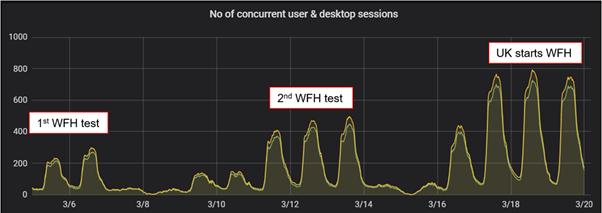
Source: Man Group; as of 31 March 2020.
New Tool Adoption
We saw tremendous uptake of the new tools that were deployed to our staff. Figure 4 shows the increase in the number of users logged into Slack and posting in it after rollout across the firm on 16 March. As of mid-May, more than 984 public Slack channels had been created.
Figure 4: Total Slack Users
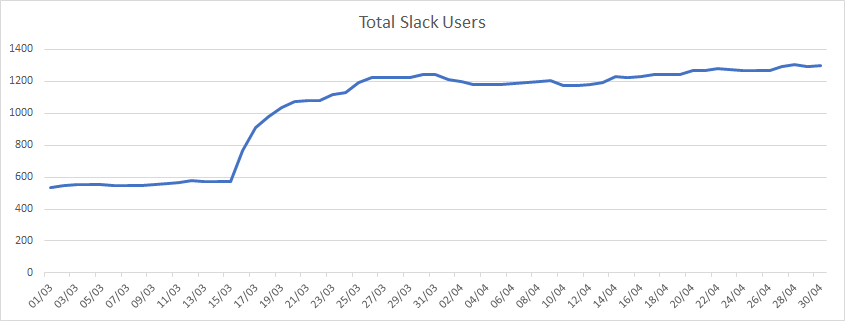
Source: Man Group; as of 30 April 2020.
When it came to Webex, within a week, the company went from spending the first five minutes of every meeting getting logged in, to everyone starting on time with webcams and headsets working perfectly. We are now running up to 1,000 meetings a day using the platform (Figure 5).
Figure 5: Total Webex Meetings per Day
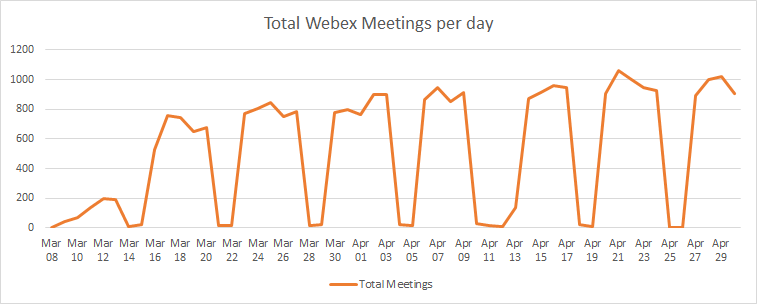
Source: Man Group; as of 3 June 2020.
These tools have all played an important role in this new working environment. Not only have they allowed us to maintain levels of productivity and collaboration that are comparable to those achieved when working in the office environment, but they have also provided helpful support and data points from a wellbeing perspective. The ability to see your colleagues over video, and the informality that Slack affords compared with email, have been incredibly helpful at maintaining relationships and providing the support needed by our staff in these challenging circumstances. Slack channels have been created to promote and publicise upcoming online events, such as quizzes and end-of-day social gatherings, as well as recommendations for books, TV series and films. In addition to using Webex for meetings, it has been utilised to run the weekly departmental quiz, social gatherings and live fitness classes.
Support
We saw an obvious increase in support tickets coming into the team, during the initial tests and then when everyone began working from home. What was pleasing to see was how quickly these came down to normal levels within a couple of weeks suggesting that staff quite quickly got to grips with working from home from a technical perspective.
Figure 6: Support Tickets
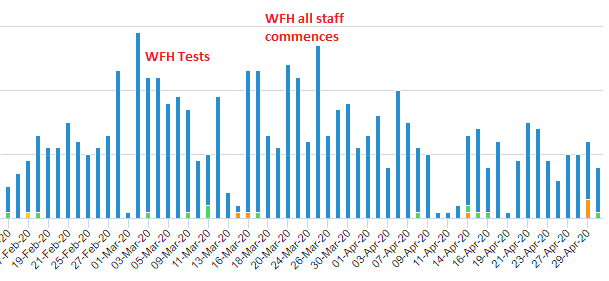
Source: Man Group; as of 30 April 2020.
Whilst the Citrix solution allowed people to connect to a virtual desktop if needed, the majority of staff connected back to their desktop in the office. We have therefore needed to maintain a very limited presence in our office to help with restarting failed machines or turning on those that were accidentally shutdown!
We are still sending one member of our End User Support team to our London office each day, and as required in our regional offices. Man Group has covered private transport and meal costs, and staff follow social distancing recommendations while on site. It has made us think how we can improve our remote support skills, and the team have been pushed to try everything before asking the onsite engineer. It also led us to consider other proactive steps we could take to reduce the need to physically restart devices. To prevent staff powering down their PCs, we've hidden the option to do so, and we've been working with the Networks team the implement "Wake on LAN" functionality that allows PCs to be remotely managed and started even when they're powered off.
Offering Slack has introduced a new way to interact quickly and easily with our support teams. Whilst this is fantastic for our staff, and reduces barriers to get help, it has required us to include another medium to monitor, and one where people want a prompt response. Conversely, Slack allows the End User Support teams to communicate with other technology teams to investigate issues and share information across the team.
Finally, we have had to amend the support hours we offer to cover weekends and a longer working day. Some of the heightened demand came from the high trading volumes during March and April, but the amendment was also driven by staff working early or late to care for children or dependents during normal working hours.
New Joiners
One challenge that our Support teams faced was how to handle new staff joining the firm when all our offices were closed and we couldn't meet with them or hand over new hardware. We were able to address that by bringing forward the rollout of a much more proactive on-boarding process and using Webex as a means to provide that. Feedback on the new process has been overwhelmingly positive and means we can get our staff up and running, writing code, meeting their new colleagues and being trained on our applications on day one.
Scalability
In the space of a couple of weeks, enterprises across the world sent their staff home and set them up with new Cloud based tools like Zoom, Teams, Skype and Webex. During the first few weeks several of these vendors experienced outages or performance issues as the number of daily users surpassed all previous expectations. Although we have a huge amount of respect and sympathy for our peers at those organisations, the issues did cause support problems for our staff and impacted their perceptions of the new tools we'd launched. Our teams integrated the Cloud providers’ status and performance monitoring services with our own internal systems to make sure we had access to the latest information. Over time, the performance and reliability of most services has stabilised as they scaled up to meet this new demand.
Conclusion
Whilst we saw some minor issues, the overwhelming outcome was positive: our staff and the systems they had built played a key role in enabling Man Group to transition its workforce to work remotely.
This article focused on the preparation work done in the weeks leading up to lockdown, but the most significant reason for the success of our remote working systems and support was Man Group's investment in End User Technology over the last two years. The last-minute preparation helped, but long-term and continued investment in products that staff use is critical. Our areas of focus have been flexibility; the ability for our staff to work from any location, and collaboration, the ability for them to interact with each other. These were underpinning themes for much of the work we had planned for the next year, and the importance of accelerating the digital transformation these represent is now even greater.
At the point of writing this article, we continue to work from home. Focus now moves to when we might return, and in what format and structure that might be. We'll undoubtedly see a more hybrid working setup for an interim period, with staff both at home and in the office, so it is key we make the interactions between these two environments seamless. On top of that, our staff and our management team now have a far better understanding of how they and the company can work remotely. Will people want to return to work five days a week? Are people more likely to want to work remotely in the future? Office provision and design will likely see massive change over the next months and years and the Technology team will be a key support to that process.
You are now leaving Man Group’s website
You are leaving Man Group’s website and entering a third-party website that is not controlled, maintained, or monitored by Man Group. Man Group is not responsible for the content or availability of the third-party website. By leaving Man Group’s website, you will be subject to the third-party website’s terms, policies and/or notices, including those related to privacy and security, as applicable.